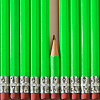Or search by topic
Number and algebra
Geometry and measure
Probability and statistics
Working mathematically
Advanced mathematics
For younger learners
Tin Tight



- Problem
- Getting Started
- Student Solutions
- Teachers' Resources
The NRICH problems are organised into Stages (Tin Tight is a Stage 4 problem), and the solutions selected are those that use the repertoire of mathematical knowledge at that level.
Tin Tight would be a straightforward problem at Stage 5 where a technique from a topic called Calculus would produce a routine solution very easily.
At Stage 4 a Trial & Improvement approach would work well, using either a calculator or a spreadsheet.
Alternatively software or calculators that plot graphs from algebraic functions will produce an interesting visual representation of the same approach.
Well done to Zoà « from Bournemouth and to James and Mary from Edinburgh. Here's how they tackled the problem
First of all we imagined some extreme tin proportions.
If the height was really small, say $1\; \text{cm}$, then the tin would have to be enormously wide to still hold a litre, and that means having a big lid and bottom area.
If, on the other hand, the height got very large the tin would be like a tube.
We weren't sure straight away whether that made the all round area bigger or smaller. So we tried some calculations and it looked like the area got bigger for taller (thinner) tins.
If the height was $10 \; \text{cm}$ the base area had to be $100 \;\text{cm}^2$ because we know that the volume's going to be $1000 \; \text{cm}^3$. Then the base is a circle so an area of $100 \; \text{cm}^2$ means a radius of $5.64 \; \text{cm}$ which is a diameter of $11.28 \; \text{cm}$. The curved part of the tin is a wrapped round rectangle. And tin height and base circumference gives us the dimensions to calculate that area. Then we just add the base and the lid, which is the same as the base, and that gave a total area of about $554 \; \text{cm}^2$. Next we tried a height of $50 \; \text{cm}$. That tin had a total area of about $832 \; \text{cm}^2$. Heights of $100\; \text{cm}$, $500 \; \text{cm}$ and $1000 \; \text{cm}$ had areas of $1141\; \text{cm}^2$, $2511\; \text{cm}^2$ and $3547\; \text{cm}^2$. So you can see that it looks like taller tins use more material to make them.Now to find the best value. That is the height of the tin that needs as little material as possible and still holds $1$ litre.
Rather than keep using the calculator we decided to use Excel, because it was the same calculation over and over but just with height changed by a steady amount each time.
Here's what we got (A is the base area which is a circle, and D is the diameter of that circle. The formulae in the cells just do the calculations we already explained)
That is just part of the sheet. Our H numbers actually went up as far as $100$.
We also made Excel show the results as a graph, which made us more sure that the best height was well before $20 \; \text{cm}$
Next we reduced the increase amount for H to get a more accurate result.
We already knew that the answer would be near $11$
It seems like we need a height of about $10.84 \; \text{cm}$ and that gives a diameter which is the same as the height. We did try using more and more decimal places just to make sure.
Our conclusion is that it looks very much like having the height and diameter both the same will make the most efficient tin.
Which is a bit surprising and rather nice!
Although, except by doing the calculation, we can't see why it should be that proportion.
What about $5$ litres?
We could invent a new unit of capacity that was equal to $5$ litres. Then all our calculations and reasoning would remain the same. The best proportion would still be when the diameter and height were equal. So this is the best proportion for any size tin.
For those who like to look ahead Alison from Guildford shows how quick the result can be using Stage 5 mathematics :
For a cylinder, volume (V) is $\pi r^2 h$. And the total surface area (A) is $2\pi r^2+2\pi rh$. But if V is specified, h will depend on r. The formula is $h={V\over\pi r^2}$. And using that to replace $h$ in theformula for total surface area: $A=2\pi r^2+{2\pi rV\over\pi r^2}$. Sketching the area function (A) is straightforward.$r^2$ (blue) and ${1\over r}$ (green) are simple curves, so the Area Function looks like this.
From this we can see that there is only one r value to consider and that that position is a minimum.
Differentiate the Area Function to get its Gradient Function: $$4\pi r-{2000\over r^2}$$ (that was the Calculus bit!)
And this function is zero when $r$ is $5.419261$
So the minimum surface area for the cylinder happens when $r$ is $5.419261$, that is a diameter of $10.83852$ and when the height is also $10.83852$ using the formula (above) for $h$ when $r$ is known
You may also like

F'arc'tion
At the corner of the cube circular arcs are drawn and the area enclosed shaded. What fraction of the surface area of the cube is shaded? Try working out the answer without recourse to pencil and paper.

